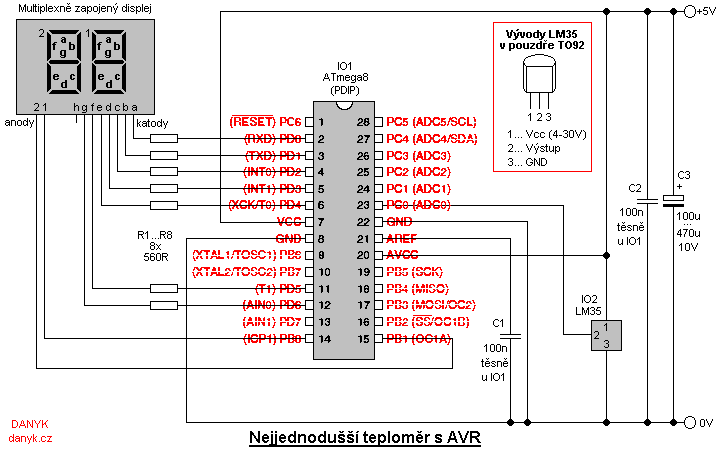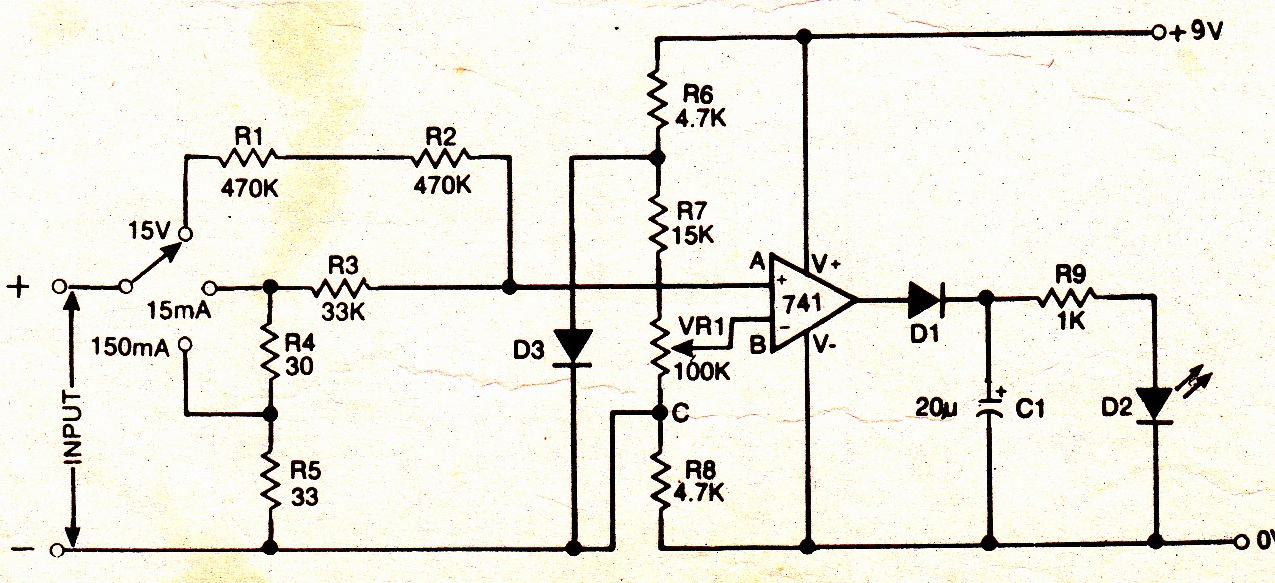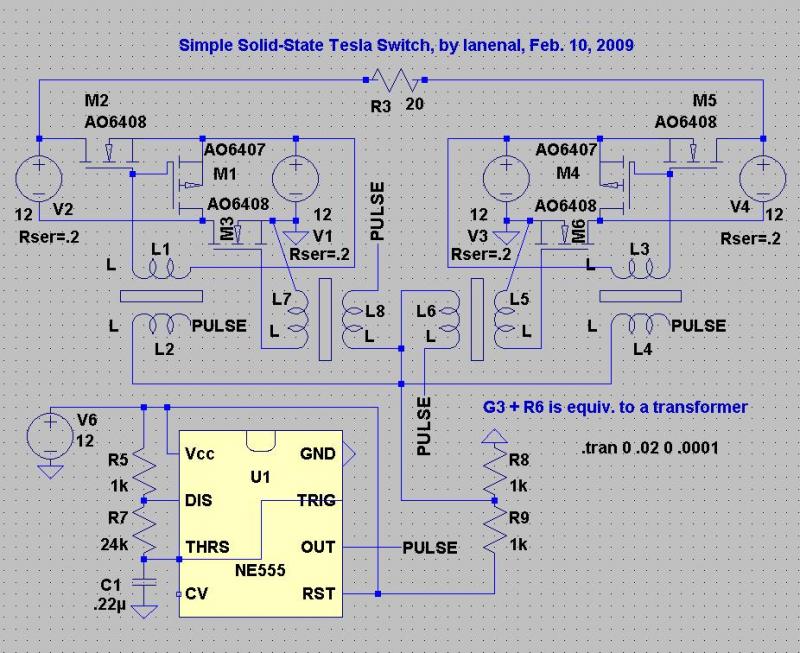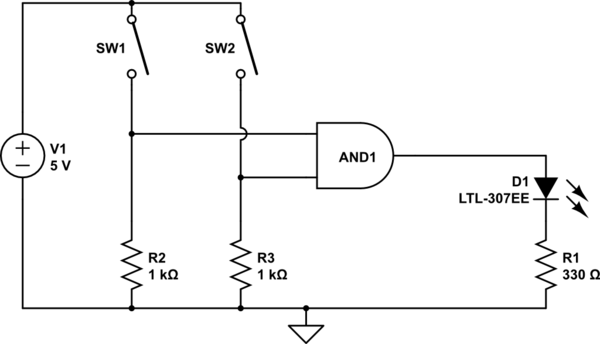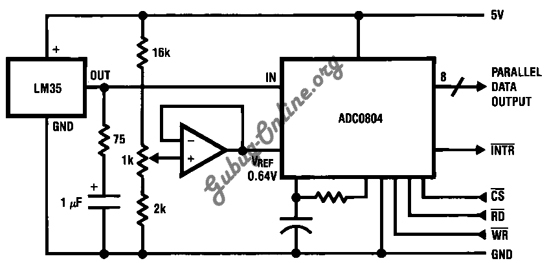
The simplest digital LCD voltmeter with AVR
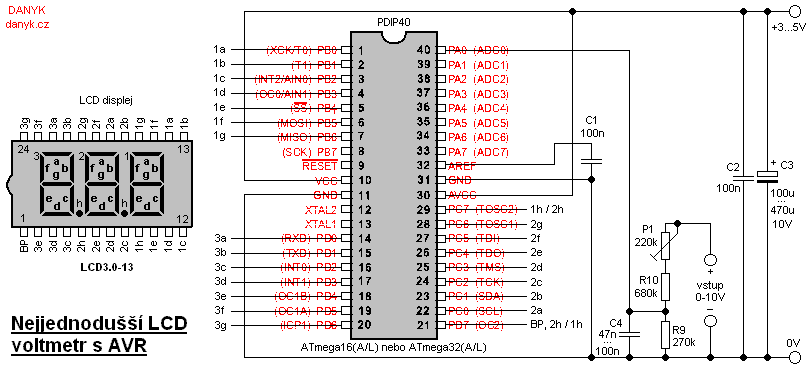
This is likely the simplest digital voltmeter utilizing an Atmel AVR microcontroller and an LCD display. The circuit is managed by a microprocessor IO1 - AVR Atmel ATmega16A, ATmega16L, ATmega16, ATmega32A, or ATmega32. A program is available for free download along with configuration bits setting. The three-digit seven-segment LCD display is employed to show the voltage value. The LCD type used is LCD3. This display is driven by a rectangular AC voltage at a frequency of approximately 50Hz. Active segments are connected to a voltage in phase with a common electrode, known as the backplane (BP), while inactive segments are connected to a voltage in phase with the common electrode. The circuit utilizes a single-ended 10-bit ADC of the AVR, with output values ranging from 0 to 1023. As a fourth digit is unnecessary for the limited range of 1000 - 1023, the range is confined to 0 - 999. When the input voltage exceeds this range, the display indicates a symbol "- - -". The scale corresponds to an input voltage of 2.5V. The input voltage divider, consisting of resistors R9, R10, and potentiometer P1, reduces the voltage by a factor of 4, allowing for a 10V range with a resolution of 0.01V. The input impedance is approximately 1MΩ. For a 100V range, replace R10 with 9.1MΩ and P1 with 2.2MΩ to achieve a 100V range with a resolution of 0.1V and an input impedance of around 10MΩ. Calibration of the voltmeter is performed using P1 while a known voltage is applied. The decimal point can be selected as needed (1h or 2h) and connected to pin 29 (PC7). The unused point should be connected to pin 21 (PD7) and subsequently to BP, ensuring no voltage is present relative to BP (avoid leaving the point "in free air"). The refresh rate of the voltmeter is approximately 4Hz. IO1 employs an internal RC oscillator set to 1MHz. The circuit operates on a supply voltage of approximately 3-5V for ATmega16A, ATmega32A, ATmega16L, and ATmega32, or 4.5-5V for ATmega16 and ATmega32 (although experimental results suggest that ATmega32 may function at 3V, this is not guaranteed by the datasheet). Current consumption is about 0.2 to 0.4mA at 3V and approximately 2-4mA at 5V. This voltmeter can serve as an enhancement for a lab power supply, vehicle board voltage indicator, PC power supply voltage meter, UPS battery voltage meter, etc. The supply voltage can be derived from a basic power supply using components such as the 7805, LM317, or a Zener diode. It is advisable to include a suitable fuse at the power input.
The digital voltmeter circuit is designed to provide a straightforward solution for measuring voltage levels across various applications. It employs an Atmel AVR microcontroller, which serves as the core processing unit. The selected microcontrollers (ATmega16A, ATmega16L, ATmega16, ATmega32A, or ATmega32) are well-suited for this application due to their integrated ADC capabilities and low power consumption.
The LCD display, specifically the LCD3 type, is integral for visual feedback, allowing users to easily read voltage values. The driving mechanism of the display relies on a 50Hz rectangular AC voltage, ensuring that the active segments illuminate correctly in relation to the common electrode. This design choice not only simplifies the circuit but also enhances the display's visibility.
The ADC operates within a defined range, translating the analog voltage inputs into digital values that the microcontroller can process. The decision to limit the output range to 0-999 is practical, as it aligns with the display capabilities and the expected input voltage levels. The input voltage divider formed by R9, R10, and P1 is critical for scaling down higher voltages to a manageable level for the ADC, allowing for precise measurements while maintaining a high input impedance.
Calibration is a vital step in ensuring measurement accuracy. The use of a potentiometer (P1) allows for fine-tuning, accommodating variations in input voltage. The option to select the decimal point enhances the user interface, providing flexibility based on user preferences.
Power consumption is kept low, making this voltmeter suitable for battery-operated applications. The recommended power supply components (7805, LM317, or Zener diode) facilitate easy integration into existing systems, while the inclusion of a fuse adds a layer of protection against overcurrent scenarios.
Overall, this digital voltmeter circuit represents an efficient and effective solution for voltage measurement, suitable for a variety of applications ranging from laboratory setups to automotive diagnostics.This is probably the simplest possible digital voltmeter with Atmel AVR microcontroller and LCD display. The circuit is controlled by a microprocessor IO1 - AVR Atmel ATmega16A, ATmega16L, ATmega16, ATmega32A, ATmega32L or ATmega32.
Below is a program to download for free and configuration bits setting printscreen. The three digit seven segment LC D display is used to display the voltage value. I used the LCD3. 0-13 type. The display is driven by a rectangular AC voltage at a frequency of about 50Hz. Active segments are connected to a voltage in-phase with a common electrode or so called backplane (BP). Inactive segments are connected to a voltage in phase with the common electrode. The circuit uses single ended 10-bit AD converter of the AVR. The output value is in range of 0 to 1023. As is not worth adding a fourth digit for the narrow range of 1000 - 1023, the range is limited to 0 - 999.
When the input voltage is out of range, the display shows a symbol "- - -". The scale corresponds to an input voltage of 2. 5 V. The input divider of R9, R10 and P1 decreases the voltage by 4, providing a 10V range with a resolution of 0. 01 V. The input impedance is about 1M. (If you require a 100V range, replace R10 to 9M1 and P1 2M2. Then you`ll get 100V range with a resolution of 0. 1 V and an input impedance of around 10M. ) Calibrate the voltmeter using P1 while a known voltage is connected. Select the decimal point as needed (1h or 2h). The selected point connect to pin 29 (PC7). Unused point should be connected to pin 21 (PD7) and thus to BP, so there`s no voltage respect to BP (do not let the point "in free air").
Refresh rate of the voltmeter is about 4Hz. IO1 uses an internal RC oscillator set to 1MHz. The circuit is powered from a supply of about 3 - 5V for ATmega16A / ATmega32A / ATmega16L / ATmega32L or 4. 5 - 5V for ATmega16 / ATmega32 (according to my experiments ATmega32 operates at 3V too, but it is not guaranteed by the datasheet).
Current consumption at 3V is about 0. 2 to 0. 4 mA and at 5V it is about 2-4 mA. The voltmeter can be useful as an improvement for a lab power supply, vehicle board voltage indicator, the PC power supply voltage meter, UPS battery voltage meter, etc. The supply voltage can be obtained using a simple power supply using for exampe the 7805, LM317 or a zener diode.
Put the proper fuse at the power input. 🔗 External reference
The digital voltmeter circuit is designed to provide a straightforward solution for measuring voltage levels across various applications. It employs an Atmel AVR microcontroller, which serves as the core processing unit. The selected microcontrollers (ATmega16A, ATmega16L, ATmega16, ATmega32A, or ATmega32) are well-suited for this application due to their integrated ADC capabilities and low power consumption.
The LCD display, specifically the LCD3 type, is integral for visual feedback, allowing users to easily read voltage values. The driving mechanism of the display relies on a 50Hz rectangular AC voltage, ensuring that the active segments illuminate correctly in relation to the common electrode. This design choice not only simplifies the circuit but also enhances the display's visibility.
The ADC operates within a defined range, translating the analog voltage inputs into digital values that the microcontroller can process. The decision to limit the output range to 0-999 is practical, as it aligns with the display capabilities and the expected input voltage levels. The input voltage divider formed by R9, R10, and P1 is critical for scaling down higher voltages to a manageable level for the ADC, allowing for precise measurements while maintaining a high input impedance.
Calibration is a vital step in ensuring measurement accuracy. The use of a potentiometer (P1) allows for fine-tuning, accommodating variations in input voltage. The option to select the decimal point enhances the user interface, providing flexibility based on user preferences.
Power consumption is kept low, making this voltmeter suitable for battery-operated applications. The recommended power supply components (7805, LM317, or Zener diode) facilitate easy integration into existing systems, while the inclusion of a fuse adds a layer of protection against overcurrent scenarios.
Overall, this digital voltmeter circuit represents an efficient and effective solution for voltage measurement, suitable for a variety of applications ranging from laboratory setups to automotive diagnostics.This is probably the simplest possible digital voltmeter with Atmel AVR microcontroller and LCD display. The circuit is controlled by a microprocessor IO1 - AVR Atmel ATmega16A, ATmega16L, ATmega16, ATmega32A, ATmega32L or ATmega32.
Below is a program to download for free and configuration bits setting printscreen. The three digit seven segment LC D display is used to display the voltage value. I used the LCD3. 0-13 type. The display is driven by a rectangular AC voltage at a frequency of about 50Hz. Active segments are connected to a voltage in-phase with a common electrode or so called backplane (BP). Inactive segments are connected to a voltage in phase with the common electrode. The circuit uses single ended 10-bit AD converter of the AVR. The output value is in range of 0 to 1023. As is not worth adding a fourth digit for the narrow range of 1000 - 1023, the range is limited to 0 - 999.
When the input voltage is out of range, the display shows a symbol "- - -". The scale corresponds to an input voltage of 2. 5 V. The input divider of R9, R10 and P1 decreases the voltage by 4, providing a 10V range with a resolution of 0. 01 V. The input impedance is about 1M. (If you require a 100V range, replace R10 to 9M1 and P1 2M2. Then you`ll get 100V range with a resolution of 0. 1 V and an input impedance of around 10M. ) Calibrate the voltmeter using P1 while a known voltage is connected. Select the decimal point as needed (1h or 2h). The selected point connect to pin 29 (PC7). Unused point should be connected to pin 21 (PD7) and thus to BP, so there`s no voltage respect to BP (do not let the point "in free air").
Refresh rate of the voltmeter is about 4Hz. IO1 uses an internal RC oscillator set to 1MHz. The circuit is powered from a supply of about 3 - 5V for ATmega16A / ATmega32A / ATmega16L / ATmega32L or 4. 5 - 5V for ATmega16 / ATmega32 (according to my experiments ATmega32 operates at 3V too, but it is not guaranteed by the datasheet).
Current consumption at 3V is about 0. 2 to 0. 4 mA and at 5V it is about 2-4 mA. The voltmeter can be useful as an improvement for a lab power supply, vehicle board voltage indicator, the PC power supply voltage meter, UPS battery voltage meter, etc. The supply voltage can be obtained using a simple power supply using for exampe the 7805, LM317 or a zener diode.
Put the proper fuse at the power input. 🔗 External reference
